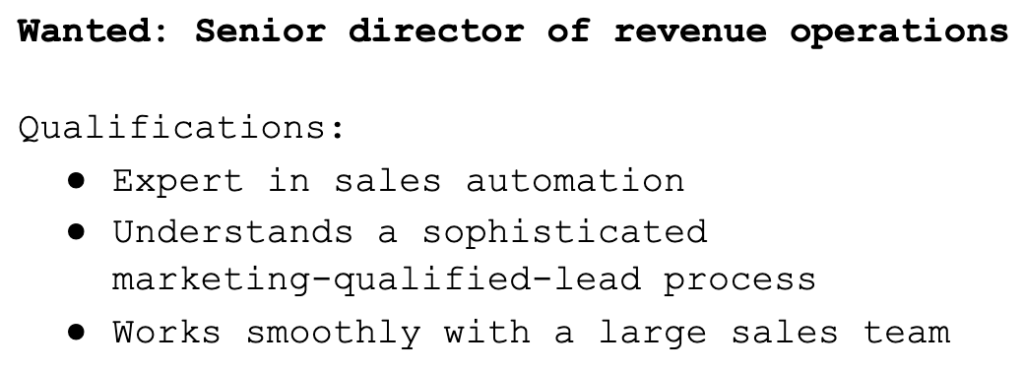Imagine if, 30 years from now, business leaders are still scratching their heads about how to use artificial intelligence. It’s nearly impossible to believe that will be true.
Yet a similar phenomenon has already happened with another technology: sales and marketing automation.
Back in 1989, when hair metal music played on MTV and a lone protester famously stood in front of a tank in Tiananmen Square, the Harvard Business Review published an article that explored how automation was ready to boost marketing and sales teams.
“These [systems] make direct sales and direct marketing more efficient by automating highly repetitive support tasks … and by reducing the time salespeople spend on non-selling tasks, like scheduling sales calls, compiling sales reports, generating proposals and bids, and entering orders,” the article proclaimed.
But more than 30 years later, we are still talking about these same productivity gains — and automation remains elusive for many sales and marketing teams. Why has automation failed to gain traction despite its obvious promise?
The answer has little to do with the technology itself. The problem, it turns out, is that the people who need those tools the most simply don’t know how to use them.
A Lack of Training
Harvard Business Review foretold this problem in that old article, noting that installing and using automation tools “requires expertise in technology (computers, data communications, and software) as well as in marketing and sales.”
For a long time, few people could complete that punch list. But within the last few years, two things began to change that improved automation’s chances: Sales and marketing teams began to broaden their tech chops, and data quality got a whole lot more important.
Traditionally, software developers and designers worked in their own world, and marketers and sales reps stuck to theirs. Co-mingling resulted in misunderstood business priorities, different views on what end-users needed, and even opposing languages. One side deployed code; the other deployed prospecting campaigns.
“On the face of it, it does seem that the [B2B] industry doesn’t move at the pace that it should in adopting technology,” says Aditya Gupta, assistant professor of marketing at Texas State University and a former product development leader at IT and telecommunications firms.
Training wasn’t as immersive as it needed to be, either, says Gupta, who recently co-authored a research paper on this topic for the Journal of Business Research. He points out that companies often make the mistake of introducing a new tool and then failing to follow up to ensure that employees are using it effectively.
“Continuous training can help overcome challenges and associated stress of technology adoption,” he notes, “and also build confidence and the belief that technology tools can help salespeople and marketers achieve their goals and objectives.”
The Rise of Cross-Functional Teams
Throughout the 2010s, a noticeable shift happened in the business world as departments started cooperating more in the name of greater efficiency. Companies broke down silos between teams and forced them to collaborate on business goals.
Employees who were not software developers but nonetheless had technical know-how started to bridge across disparate teams. Marketing and sales operations consequently became more proficient with technology. They learned to use the software better.

At ZoomInfo, this type of thinking isn’t just for one position; rather, it’s a philosophy embedded throughout the company. For example, technical operations such as automation function within sales and marketing instead of being segregated to IT or engineering departments. The idea of permanently knocking down traditional technology silos is at the heart of this approach.
The strategy goes beyond teams and stretches to the top of the organizational chart. The chief marketing officer, head of technology and ops, and sales vice presidents report to ZoomInfo’s chief operating officer. This structure creates cohesion across marketing and sales operations efforts because ops activities flow down from senior leaders.
Better Data Means Smarter Automation
In 1989, that Harvard Business Review article cited data as the key to finding out what customers are really looking for.
“Whenever marketing or sales activities are performed, the database captures information that answers questions about customers and their needs,” the article noted. “What were their interests? How were these interests generated?”
But it wasn’t until recently that teams began to realize a greater benefit to feeding quality data into automation platforms.
Scott Brinker, HubSpot’s vice president of platform ecosystems, says interest in consumer privacy and corporate data quality soared in 2018, when the General Data Protection Regulation (GDPR) went into effect. Companies realized that improved data quality helps them comply with privacy laws and strengthens their bottom line by giving sales and marketing teams a more targeted list of prospects to feed into automated systems.
“Initially inspired from a compliance requirement, marketers have just gotten a lot tighter on the quality of their data,” Brinker said on a recent episode of ZoomInfo’s podcast “Talk Data To Me.” “You need quality data in order to be able to rely on what those machine learning algorithms are doing.”
Brinker says getting a more accurate picture of a customer through solid data is “a hidden benefit that came out of GDPR.”
As automated algorithms have also improved over the years, combining those advancements with high-quality data has led to new innovations that make sales and marketing professionals more efficient, he explains.
The Pandemic Effect
The sudden economic changes brought about by COVID-19 last year broke down barriers to adoption of automation tools and other tech by salespeople and marketers.
“The pandemic forced a lot of these organizations to look at technology more seriously,” Gupta says.
And more people within a company are becoming familiar with tech products, says Chris Hays, chief operating officer at ZoomInfo. Before COVID, an executive might have solely made a buying decision for a team. But fear of the unknown with the pandemic caused executives to bring in other decision-makers to confirm that purchase plans were justified.
“There’s a group of people around that decision that wasn’t there before,” Hays says.
As the sphere of decision-makers expands, so does the time it takes to evaluate and purchase technology. Perhaps this drawn-out buying cycle explains why automation has taken so long to truly gain hold at companies despite Harvard Business Review’s early endorsement. The delay reflects an ever-growing roster of customers for automation who need more time to vet their specific use cases.
A New Generation
With an expanding user base, sellers of automation platforms must recast the value that this tech brings. Younger users recognize the business benefits of new tech and proved to be early adopters of new products during the pandemic.
“When they look at technology, they have a certain sense of how it should be,” Gupta says.
Ironically, a decades-old dilemma about automation might be sorted out by the newest generation of sales reps and marketers. Combined with departmental barriers tumbling and data quality rising in importance, automation may finally complete the evolution it began more than a generation ago.
Which begs the question: What will we be talking about 30 years from now?

